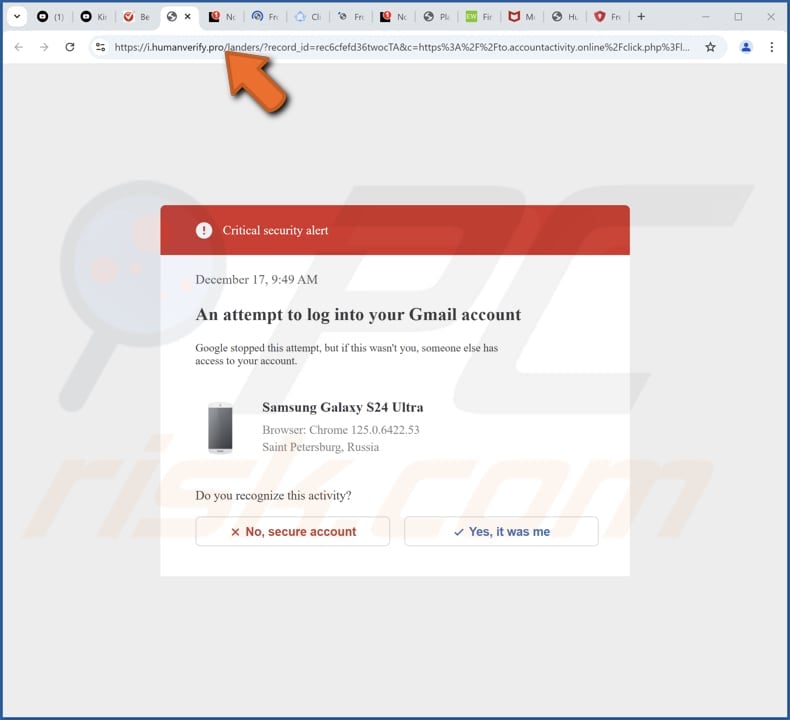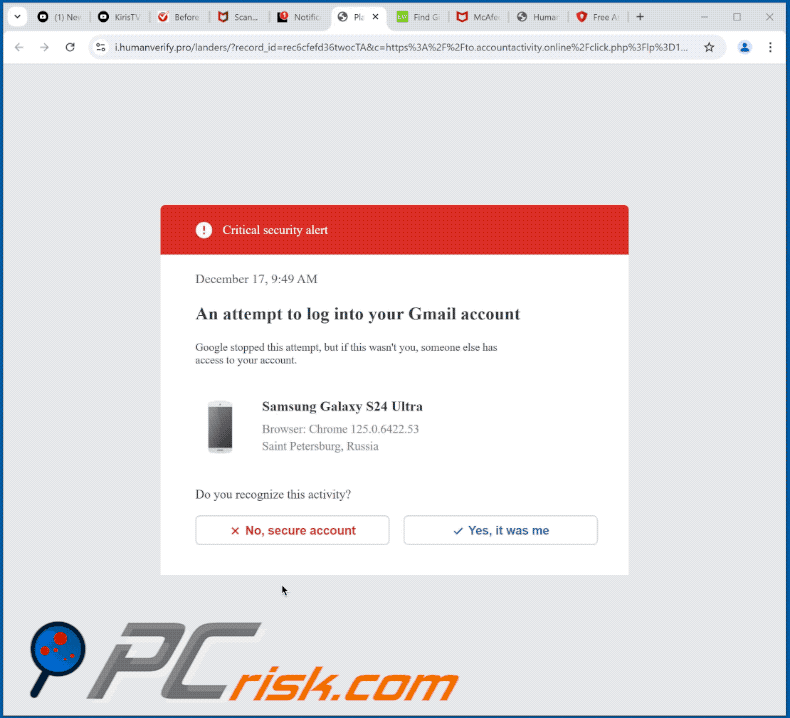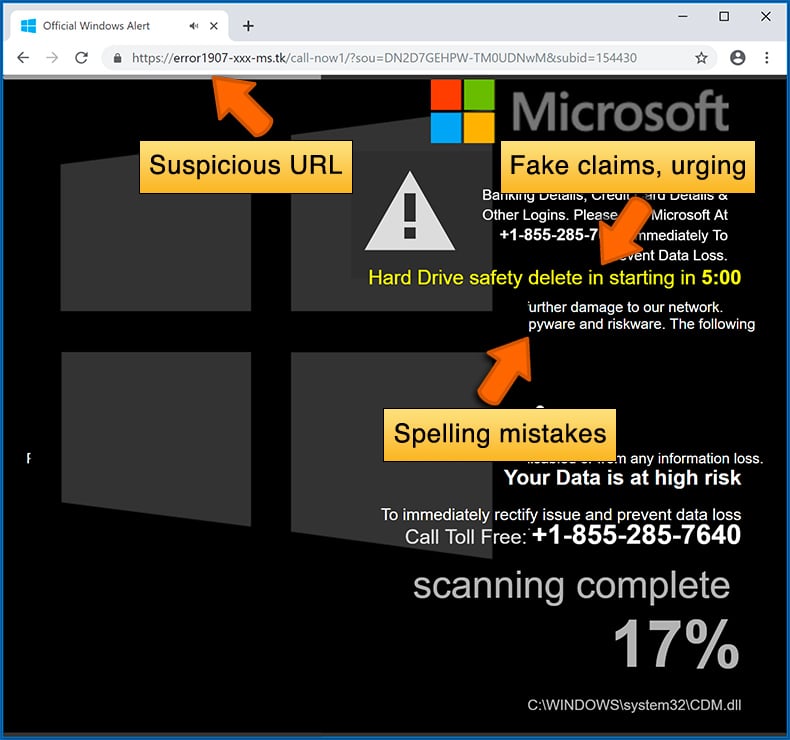How to recognize scams like "Attempt To Log Into Your Gmail Account"
Phishing/ScamAlso Known As: Fake Attempt To Log Into Your Gmail Account warning
Get free scan and check if your device is infected.
Remove it nowTo use full-featured product, you have to purchase a license for Combo Cleaner. Seven days free trial available. Combo Cleaner is owned and operated by RCS LT, the parent company of PCRisk.com.
What is "Attempt To Log Into Your Gmail Account" scam?
We have reviewed this website and found that it runs a pop-up scam. On this site, a deceptive message is presented to trick visitors into taking certain actions. Users should not trust such pages and close them if encountered to avoid security and privacy risks. Engaging with such sites can lead to malware infections, data theft, or other harmful consequences.

"Attempt To Log Into Your Gmail Account" scam in detail
The deceptive message on this site is disguised as a "Critical Security Alert". It claims that an attempt was made to log into the user's Gmail account. It states that Google stopped the attempt, but if the user does not recognize the activity, it suggests that someone else may have tried to access the account.
The message includes fake details like the device (Samsung Galaxy S24 Ultra), browser version, and location (Saint Petersburg, Russia) to make the alert appear legitimate. It also provides two options: "No, secure account" and "Yes, it was me". The purpose of this scheme is to lure the visitors into engaging with it.
When one of the options is chosen, the site presents another fake security alert. The second deceptive message states that the user's Gmail account has been hacked. It warns that recently installed software might contain a virus, and the user's PC is at risk of infection. The message urges the user to perform an antivirus scan to ensure their computer's safety.
Also, it is disguised as an alert from McAfee, a security tool owned by a legitimate computer security software company. Legitimate companies do not use deceptive web pages or similar techniques to promote their products or services.
Overall, this fraudulent scheme likely aims to lure unsuspecting individuals into disclosing personal information, downloading harmful software, purchasing legitimate software (helping scammers to earn illegitimate commissions), or taking other actions. Either way, shady websites displaying security alerts or other messages should be avoided and closed.
| Name | Fake Attempt To Log Into Your Gmail Account warning |
| Threat Type | Phishing, Scam, Social Engineering, Fraud |
| Fake Claim | User's Google account has been hacked |
| Disguise | Legitimate security alert |
| Related Domain | n.system-info[.]site, i.humanverify[.]pro |
| Detection Names | Forcepoint ThreatSeeker (Suspicious), Full List Of Detections (VirusTotal) |
| Symptoms | Fake error messages, fake system warnings, pop-up errors, hoax computer scan. |
| Distribution methods | Compromised websites, rogue online pop-up ads, deceptive emails, unwanted applications. |
| Damage | Loss of sensitive private information, monetary loss, identity theft, possible malware infections. |
| Malware Removal (Windows) |
To eliminate possible malware infections, scan your computer with legitimate antivirus software. Our security researchers recommend using Combo Cleaner. Download Combo CleanerTo use full-featured product, you have to purchase a license for Combo Cleaner. 7 days free trial available. Combo Cleaner is owned and operated by RCS LT, the parent company of PCRisk.com. |
Similar scams in general
Scams involving fake alerts or similar messages are designed to create urgency and trick users into taking harmful actions. These scams can lead to malware infections, personal data theft, or monetary loss. Users should always verify the legitimacy of such messages before taking action.
Examples of similar scams are "Viruses Have Been Detected On Your Phone", "McAfee - Computer Is At Risk Of Virus Infection", and "Microsoft Windows Locked Due To Unusual Activity".
How did I open a scam website?
Users often land on scam websites through misleading pop-ups, ads, and links on untrustworthy websites, as well as through notifications from other untrustworthy sites. They are also promoted via rogue advertising networks often used by torrent sites, adult pages, illegal streaming platforms, etc.
Scammers may also send fraudulent emails with links or attachments to lure users into visiting scam sites. Additionally, adware and other unreliable software can be used to promote these scams. In most cases, users unknowingly end up on these deceptive pages.
How to avoid visiting scam pages?
Do not click pop-ups, ads, links, buttons, or other elements on dubious websites, and do not permit such websites to send you notifications. Regularly scan your computer for malware and threats, keep your software and operating system up to date, and use reputable security tools to safeguard your system.
Be careful with suspicious emails containing links or files - do not open the contents of such emails without being sure they are harmless. Also, use reliable search engines and download apps or files only from official websites or trusted app stores. If your computer is already infected with unwanted apps, we recommend running a scan with Combo Cleaner Antivirus for Windows to automatically eliminate them.
The appearance of "Attempt To Log Into Your Gmail Account" scam (GIF):

Text in the first fake message:
Critical security alert
-
An attempt to log into your Gmail account
Google stopped this attempt, but if this wasn't you, someone else has access to your account.
Samsung Galaxy S24 Ultra
Browser: Chrome 125.0.6422.53
Saint Petersburg, RussiaDo you recognize this activity?
[No, secure account] [Yes, it was me]
Text in the second fake alert:
Security Alert
Your Gmail account has been hacked !!!
The software you recently installed might contain a virus.
Your PC is at risk of being infected by viruses
To ensure your PC's safety - perform an antivirus scan
Instant automatic malware removal:
Manual threat removal might be a lengthy and complicated process that requires advanced IT skills. Combo Cleaner is a professional automatic malware removal tool that is recommended to get rid of malware. Download it by clicking the button below:
DOWNLOAD Combo CleanerBy downloading any software listed on this website you agree to our Privacy Policy and Terms of Use. To use full-featured product, you have to purchase a license for Combo Cleaner. 7 days free trial available. Combo Cleaner is owned and operated by RCS LT, the parent company of PCRisk.com.
Quick menu:
- What is Fake Attempt To Log Into Your Gmail Account warning?
- How to identify a pop-up scam?
- How do pop-up scams work?
- How to remove fake pop-ups?
- How to prevent fake pop-ups?
- What to do if you fell for a pop-up scam?
How to identify a pop-up scam?
Pop-up windows with various fake messages are a common type of lures cybercriminals use. They collect sensitive personal data, trick Internet users into calling fake tech support numbers, subscribe to useless online services, invest in shady cryptocurrency schemes, etc.
While in the majority of cases these pop-ups don't infect users' devices with malware, they can cause direct monetary loss or could result in identity theft.
Cybercriminals strive to create their rogue pop-up windows to look trustworthy, however, scams typically have the following characteristics:
- Spelling mistakes and non-professional images - Closely inspect the information displayed in a pop-up. Spelling mistakes and unprofessional images could be a sign of a scam.
- Sense of urgency - Countdown timer with a couple of minutes on it, asking you to enter your personal information or subscribe to some online service.
- Statements that you won something - If you haven't participated in a lottery, online competition, etc., and you see a pop-up window stating that you won.
- Computer or mobile device scan - A pop-up window that scans your device and informs of detected issues - is undoubtedly a scam; webpages cannot perform such actions.
- Exclusivity - Pop-up windows stating that only you are given secret access to a financial scheme that can quickly make you rich.
Example of a pop-up scam:

How do pop-up scams work?
Cybercriminals and deceptive marketers usually use various advertising networks, search engine poisoning techniques, and shady websites to generate traffic to their pop-ups. Users land on their online lures after clicking on fake download buttons, using a torrent website, or simply clicking on an Internet search engine result.
Based on users' location and device information, they are presented with a scam pop-up. Lures presented in such pop-ups range from get-rich-quick schemes to fake virus scans.
How to remove fake pop-ups?
In most cases, pop-up scams do not infect users' devices with malware. If you encountered a scam pop-up, simply closing it should be enough. In some cases scam, pop-ups may be hard to close; in such cases - close your Internet browser and restart it.
In extremely rare cases, you might need to reset your Internet browser. For this, use our instructions explaining how to reset Internet browser settings.
How to prevent fake pop-ups?
To prevent seeing pop-up scams, you should visit only reputable websites. Torrent, Crack, free online movie streaming, YouTube video download, and other websites of similar reputation commonly redirect Internet users to pop-up scams.
To minimize the risk of encountering pop-up scams, you should keep your Internet browsers up-to-date and use reputable anti-malware application. For this purpose, we recommend Combo Cleaner Antivirus for Windows.
What to do if you fell for a pop-up scam?
This depends on the type of scam that you fell for. Most commonly, pop-up scams try to trick users into sending money, giving away personal information, or giving access to one's device.
- If you sent money to scammers: You should contact your financial institution and explain that you were scammed. If informed promptly, there's a chance to get your money back.
- If you gave away your personal information: You should change your passwords and enable two-factor authentication in all online services that you use. Visit Federal Trade Commission to report identity theft and get personalized recovery steps.
- If you let scammers connect to your device: You should scan your computer with reputable anti-malware (we recommend Combo Cleaner Antivirus for Windows) - cyber criminals could have planted trojans, keyloggers, and other malware, don't use your computer until removing possible threats.
- Help other Internet users: report Internet scams to Federal Trade Commission.
Frequently Asked Questions (FAQ)
What is a pop-up scam?
A pop-up scam is a fraudulent online tactic in which a pop-up window appears on a website. Typically, this pop-up contains a fake warning, alert, offer, or other deceptive message to trick users into engaging with it.
What is the purpose of a pop-up scam?
Scammers use these scams to steal money, extract personal information from users, distribute unwanted or malicious software, and other purposes.
Why do I encounter fake pop-ups?
Users often encounter scam websites through misleading pop-ups, ads, and links on unreliable sites, as well as rogue ad networks used by torrent, adult, and illegal streaming sites. Scammers may also send fraudulent emails with links or attachments to lure users. Adware and other malicious software can also promote scams.
Will Combo Cleaner protect me from pop-up scams?
Combo Cleaner is designed to scan every website you visit, detecting malicious ones, including sites that deliver pop-up scams. If such a site is detected, you will be immediately warned, and access will be blocked to protect your system.
Share:

Tomas Meskauskas
Expert security researcher, professional malware analyst
I am passionate about computer security and technology. I have an experience of over 10 years working in various companies related to computer technical issue solving and Internet security. I have been working as an author and editor for pcrisk.com since 2010. Follow me on Twitter and LinkedIn to stay informed about the latest online security threats.
PCrisk security portal is brought by a company RCS LT.
Joined forces of security researchers help educate computer users about the latest online security threats. More information about the company RCS LT.
Our malware removal guides are free. However, if you want to support us you can send us a donation.
DonatePCrisk security portal is brought by a company RCS LT.
Joined forces of security researchers help educate computer users about the latest online security threats. More information about the company RCS LT.
Our malware removal guides are free. However, if you want to support us you can send us a donation.
Donate
▼ Show Discussion